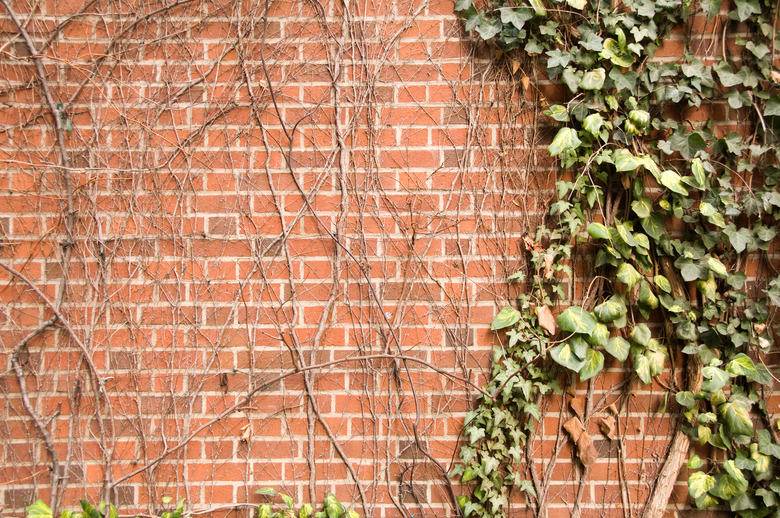How To Get Rid Of Dead Ivy On The Wall
No matter the structure, ivy climbs it and spreads. Ivy growth is especially common on brick walls, as their grooves and rough texturing provide convenient handles for ivy roots to grip. Since ivy roots are so strong, they generally remain attached to walls long after the ivy plant itself is dead. These roots eventually present challenges as they penetrate and widen crevices in walls. Dead ivy also provides shelter for insects and other pests. Promptly removing dead ivy from walls prevents damage and restores their appearance.
Step 1
Pull the dead ivy off the wall while wearing gardening gloves. Tug very gently at the vines, detaching as much overgrowth as possible.
- No matter the structure, ivy climbs it and spreads.
- Ivy growth is especially common on brick walls, as their grooves and rough texturing provide convenient handles for ivy roots to grip.
Step 2
Loosen the stuck-on roots and stems using a wooden scraper. Gently scrape the wall to avoid damaging it.
Step 3
Scrub off the dead ivy tendrils using a household scrub brush. Lightly scrub the wall if it is damaged. Remove as many dead tendrils as possible.
Step 4
Prepare a detergent solution if difficult tendrils remain on the wall. Fill an ordinary 2-gallon bucket with warm water and 1 tablespoon of liquid dishwashing detergent. Mix the soapy water well.
- Loosen the stuck-on roots and stems using a wooden scraper.
Step 5
Scrub off the remaining dead tendrils using the brush and soapy solution. Use the previous scrubbing techniques to avoid damaging the wall.
Step 6
Rinse the wall with clean water.
Rid Of Ivy On Trees
Pry a 6-inch section of the ivy vine away from the tree base. Repeat this with all the separate vines climbing up the tree. Cut through each woody vine with lopping shears to cut off contact with the roots. Loosen the vine using the screwdriver so you can make a second cut, then slowly pry the 12-inch section off the tree. If desired, use hedge shears to clip the ivy leaves, but the leaves eventually will shrivel and allow more sunlight to access the tree. Spray the cut end of the vine with an herbicide product, such as glyphosate, using a minimum of 3-percent glyphosate solution. Pull up the ivy by the roots after about one week when the herbicide has killed the ivy stubs protruding from the ground. Pull up new sprouts as soon as they develop.
- Scrub off the remaining dead tendrils using the brush and soapy solution.
- Pull up the ivy by the roots after about one week when the herbicide has killed the ivy stubs protruding from the ground.
Things Needed
- Gardening gloves
- Wooden scraper
- Household scrub brush
- 2-gallon bucket
- 1 tablespoon liquid of dishwashing detergent
- Stirring utensil
- Garden hose
Warning
Hire a professional to remove dead ivy from unsound walls, as they may crumble and become hazardous.
Tip
Cut off large ivy vines using pruning shears.
References
- Danny Lipford; Can Ivy Damage Brick or Wood on Your Home?; Julie Day
- Danny Lipford; How to Remove Ivy from Walls; Julie Day
- "This Old House"; How to Remove Ivy from a House; Roger Cook
- Fine Gardening: Genus Hedera (Ivy)
- Missouri Botanical Garden: Hedera Helix
- Monrovia: Boston Ivy
- Walter Reeves: English Ivy — Control
- Arlington Tree Stewards: Take Ivy Off Trees
- Royal Horticultural Society: Ivy on Trees and a Ground Cover Weed
- Oregon State University Extension: Fact Sheet on Ivy Removal in a Home Landscape
- BBC Earth News: English Ivy's Climbing Secrets Revealed By Scientists
